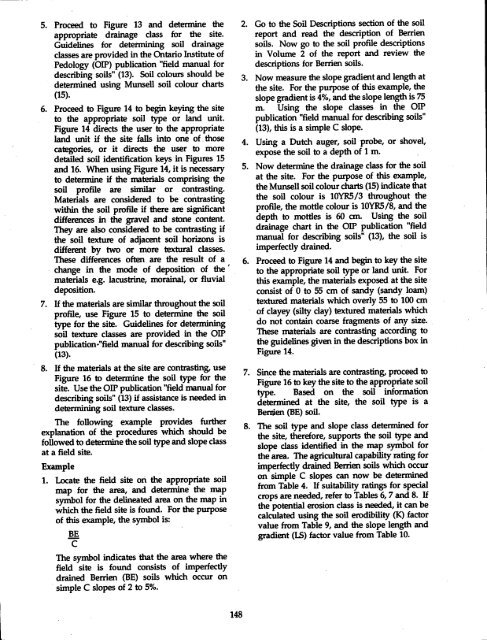The Soils of Elgin County - Agriculture and Agri-Food Canada
The Soils of Elgin County - Agriculture and Agri-Food Canada
The Soils of Elgin County - Agriculture and Agri-Food Canada
- No tags were found...
Create successful ePaper yourself
Turn your PDF publications into a flip-book with our unique Google optimized e-Paper software.
5. Proceed to Figure 13 <strong>and</strong> determine theappropriate drainage class for the site .Guidelines for determining soil drainageclasses are provided in the Ontario Institute <strong>of</strong>Pedology (OIP) publication "field manual fordescribing soils" (13) . Soil colours should bedetermined using Munsell soil colour charts(15) .6. Proceed to Figure 14 to begin keying the siteto the appropriate soil type or l<strong>and</strong> unit.Figure 14 directs the user to the appropriatel<strong>and</strong> unit if the site falls into one <strong>of</strong>, thosecategories, or it directs the user to moredetailed soil identification keys in Figures 15<strong>and</strong> 16 . When using Figure 14, it is necessaryto determine if the materials comprising thesoil pr<strong>of</strong>ile are similar or contrasting .Materials are considered to be contrastingwithin the soil pr<strong>of</strong>ile if there are significantdifferences in the gravel <strong>and</strong> stone content .<strong>The</strong>y are also considered to be contrasting ifthe soil texture <strong>of</strong> adjacent soil horizons isdifferent by two or more textural classes .<strong>The</strong>se differences <strong>of</strong>ten are the result <strong>of</strong> achange in the mode <strong>of</strong> deposition <strong>of</strong> thematerials e.g. lacustrine, morainal, or fluvialdeposition.7. If the materials are similar throughout the soilpr<strong>of</strong>ile, use Figure 15 to determine the soiltype for the site. Guidelines for determiningsoil texture classes are provided in the OIPpublication-"field manual for describing soils"(13) .8. If the materials at the site are contrasting, useFigure 16 to determine the soil type for thesite. Use the OIP publication "field manual fordescribing soils" (13) if assistance is needed indetermining soil texture classes.<strong>The</strong> following example provides furtherexplanation <strong>of</strong> the procedures which should befollowed to determine the soil type <strong>and</strong> slope classat a field site.1 . Locate the field site on the appropriate soilmap for the area, <strong>and</strong> determine the mapsymbol for the delineated area on the map inwhich the field site is found . For the purpose<strong>of</strong> this example, the symbol is :BEC<strong>The</strong> symbol indicates that the area where thefield site is found consists <strong>of</strong> imperfectlydrained Berrien (BE) soils which occur onsimple C slopes <strong>of</strong> 2 to 5% .2 . Go to the Soil Descriptions section <strong>of</strong> the soilreport <strong>and</strong> read the description <strong>of</strong> Berriensoils . Now go to the soil pr<strong>of</strong>ile descriptionsin Volume 2 <strong>of</strong> the report <strong>and</strong> review thedescriptions for Berrien soils .3. Now measure the slope gradient <strong>and</strong> length atthe site. For the purpose <strong>of</strong> this example, theslope gradient is 4%, <strong>and</strong> the slope length is 75m. Using the slope classes in the OIPpublication "field manual for describing soils"(13), this is a simple C slope.4. Using a Dutch auger, soil probe, or shovel,expose the soil to a depth <strong>of</strong> 1 m.5 . Now determine the drainage class for the soilat the site. For the purpose <strong>of</strong> this example,the Munsell soil colour charts (15) indicate thatthe soil colour is 10YR5/3 throughout thepr<strong>of</strong>ile, the mottle colour is 10YR5/8, <strong>and</strong> thedepth to mottles is 60 cm. Using the soildrainage chart in the OIP publication "fieldmanual for describing soils" (13), the soil isimperfectly drained.6. Proceed to Figure 14 <strong>and</strong> begin to key the siteto the appropriate soil type or l<strong>and</strong> unit. Forthis example, the materials exposed at the siteconsist <strong>of</strong> 0 to 55 cm <strong>of</strong> s<strong>and</strong>y (s<strong>and</strong>y loam)textured materials which overly 55 to 100 cm<strong>of</strong> clayey (silty clay) textured materials whichdo not contain coarse fragments <strong>of</strong> any size.<strong>The</strong>se materials are contrasting according tothe guidelines given in the descriptions box inFigure 14 .7. Since the materials are contrasting, proceed toFigure 16 to key the site to the appropriate soiltype . Based on the soil informationdetermined at the site, the soil type is aBerrien (BE) soil.8. <strong>The</strong> soil type <strong>and</strong> slope class determined forthe site, therefore, supports the soil type <strong>and</strong>slope class identified in the map symbol forthe area. <strong>The</strong> agricultural capability rating forimperfectly drained Berrien soils which occuron simple C slopes can now be determinedfrom Table 4. If suitability ratings for specialcrops are needed, refer to Tables 6, 7 <strong>and</strong> 8 . Ifthe potential erosion class is needed, it can becalculated using the soil erodibility (K) factorvalue from Table 9, <strong>and</strong> the slope length <strong>and</strong>gradient (LS) factor value from Table 10 .148
















